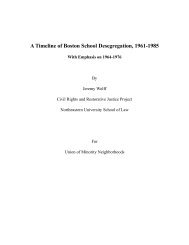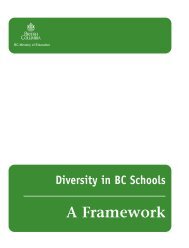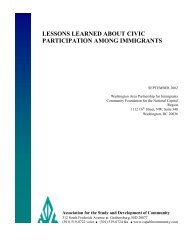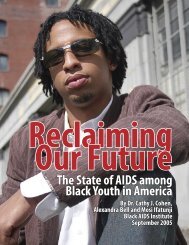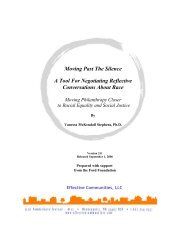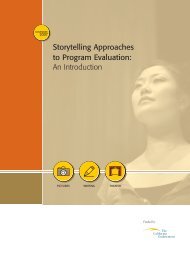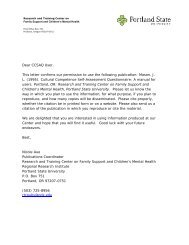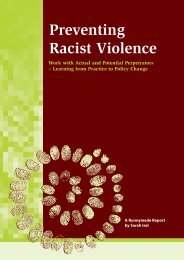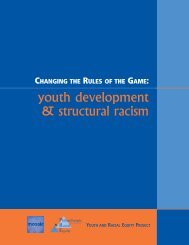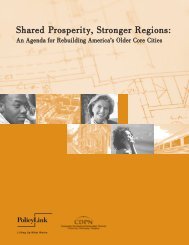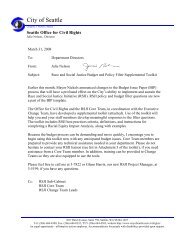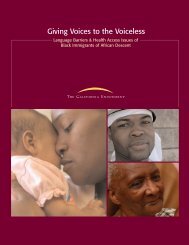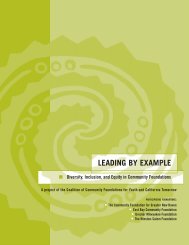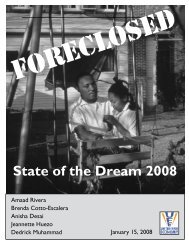REGIONAL OPPORTUNITYexpansion/service improvements, <strong>and</strong> a basis fordevelop<strong>in</strong>g a fair fare policy; <strong>and</strong>• A fair fare policy that considers, among otherfactors, distance traveled, peak <strong>and</strong> <strong>of</strong>f-peak use,<strong>and</strong> special discounts for seniors, students <strong>and</strong>the disabled (that should ma<strong>in</strong>ta<strong>in</strong> <strong>and</strong> improvethe exist<strong>in</strong>g bus-to-bus transfer policy <strong>and</strong><strong>in</strong>clude free subway-to-bus <strong>and</strong> reduced-cost busto-subwaytransfers <strong>and</strong> exp<strong>and</strong>ed hours <strong>and</strong> use<strong>of</strong> student passes for public school students).Campaign activities focused on access<strong>in</strong>g the<strong>in</strong>formation that the MBTA had used to support itsfare <strong>in</strong>crease decision through a public recordsrequest. Its ma<strong>in</strong> community organiz<strong>in</strong>g <strong>and</strong> advocacyactivities were petitions, a position paper, <strong>and</strong>participat<strong>in</strong>g <strong>in</strong> MBTA board hear<strong>in</strong>gs <strong>and</strong> otherpublic hear<strong>in</strong>g opportunities. Comb<strong>in</strong>ed, these effortsled the campaign <strong>in</strong>to direct negotiations with theMBTA’s general manager, its chief f<strong>in</strong>ancial <strong>of</strong>ficer,<strong>and</strong> the state Secretary <strong>of</strong> Transportation (who alsoserved as chair <strong>of</strong> the MBTA’s board <strong>of</strong> directors).In the end, the campaign achieved many <strong>of</strong> its goals,<strong>in</strong>clud<strong>in</strong>g:• A reduction <strong>in</strong> the proposed <strong>in</strong>crease <strong>in</strong> bus fares(the rate was changed from $0.75 to $0.90, not$1.00 as orig<strong>in</strong>ally proposed);• The creation <strong>of</strong> a Rider Oversight Committee(ROC) that will meet monthly with MBTA staff<strong>and</strong> quarterly with the state Secretary <strong>of</strong>Transportation, as well as the MBTA’s generalmanager <strong>and</strong> its chief f<strong>in</strong>ancial <strong>of</strong>ficer;• The <strong>in</strong>clusion <strong>of</strong> fare policy, fare structure, serviceimprovements, quality st<strong>and</strong>ards, <strong>and</strong> alternativefund<strong>in</strong>g sources <strong>in</strong> the ROC’s m<strong>and</strong>ate;• A fare freeze until at least January 2006;• The consultation <strong>and</strong> creation <strong>of</strong> a new farepolicy before Automated Fare Collection isimplemented;• A reduced price for bus-subway <strong>and</strong> subway-bustransfers with the Automated Fare Collectionimplementation; <strong>and</strong>• A better public process for future fare <strong>in</strong>creases.BaltimoreSimilar to New York <strong>and</strong> Boston, Baltimore’s transitriders dealt with a transit agency’s proposed fare<strong>in</strong>creases. “Farebox Recovery,” refers to the percentage<strong>of</strong> a transit agency’s expenses generated by fares. PerMaryl<strong>and</strong> law, the Maryl<strong>and</strong> Transit Authority couldrecover 40 percent <strong>of</strong> its expenses from fares. But thispercentage was to sunset <strong>in</strong> 2004, <strong>in</strong>creas<strong>in</strong>g to a 50percent farebox recovery rate, forc<strong>in</strong>g the Maryl<strong>and</strong>Transit Agency to raise its fares.Based on its equity mission <strong>and</strong> extensive experience,the Citizens Plann<strong>in</strong>g <strong>and</strong> Hous<strong>in</strong>g Association(CPHA) spearheaded the community response. Forover 60 years, CPHA has dedicated itself to the beliefthat the united action <strong>of</strong> <strong>in</strong>formed citizens is essentialto improve the quality <strong>of</strong> life for the people <strong>of</strong> theBaltimore region. In the past several years, more <strong>and</strong>more <strong>in</strong>formed citizens have made it clear that thequality <strong>of</strong> life must be addressed on both aneighborhood <strong>and</strong> a regional scale.The organization envisions a well-planned Baltimoreregion with equity among jurisdictions, wherecitizens respect diversity <strong>and</strong> have access toresponsive government <strong>and</strong> quality hous<strong>in</strong>g <strong>in</strong>vibrant neighborhoods. Its vision is to mobilize<strong>in</strong>formed citizen action by tra<strong>in</strong><strong>in</strong>g <strong>and</strong> organiz<strong>in</strong>gcitizens <strong>and</strong> neighborhood leaders to be advocates onissues consistent with the vision, advocat<strong>in</strong>g forpolicies <strong>and</strong> actions that prevent sprawl <strong>and</strong> improvethe livability <strong>of</strong> exist<strong>in</strong>g neighborhoods, <strong>and</strong>conven<strong>in</strong>g partners to address policy <strong>and</strong> plann<strong>in</strong>gissues <strong>of</strong> common <strong>in</strong>terest to Baltimore City <strong>and</strong> itssurround<strong>in</strong>g counties.Due to the 2003 fare <strong>in</strong>crease, the CPHA formed theMaryl<strong>and</strong> Transit Coalition. The Coalition is a mix<strong>of</strong> transportation advocates like the ActionCommittee for Transit <strong>and</strong> the Transit Riders League;environmental groups such as the Chesapeake BayFoundation; social justice groups such as Maryl<strong>and</strong>Public Interest Research Group (MaryPIRG); <strong>and</strong>smart growth advocates represented by theWash<strong>in</strong>gton <strong>Regional</strong> Network for LivableCommunities <strong>and</strong> Solutions Not Sprawl, amongothers. The Coalition worked to advance statelegislation—Senate Bill 282 <strong>and</strong> House Bill 282—t<strong>of</strong>reeze farebox recovery at 40 percent until 2008.With the Transit Riders League <strong>in</strong> the lead, Coalitionmembers wrote letters, sent e-mail, called theirrepresentatives, <strong>and</strong> testified at hear<strong>in</strong>gs, whichresulted <strong>in</strong> the near-unanimous approval <strong>of</strong> each Bill.On May 26, 2004, Maryl<strong>and</strong> Governor Robert L.Erlich, Jr., signed the legislation, which extended the40 percent farebox recovery requirement forBaltimore-area transit riders until 2008.97Funders’ Network for Smart Growth <strong>and</strong> Livable Communities
Funder InterestThe Straphangers Campaign receives fund<strong>in</strong>g from avariety <strong>of</strong> sources (local foundations, dues,fundraisers), but their largest source <strong>of</strong> fund<strong>in</strong>gcomes from the Alfred E. Sloan Foundation.Accord<strong>in</strong>g to the Sloan Foundation’s programdirector, Ted Greenwood, the Foundation was<strong>in</strong>terested <strong>in</strong> the Straphangers’ focus on theperformance <strong>of</strong> the New York City Transit System.The Straphangers had demonstrated an ability toobta<strong>in</strong>, analyze, <strong>and</strong> review the data produced by theMTA, us<strong>in</strong>g this data to produce reports on theperformance <strong>of</strong> different subway l<strong>in</strong>es. Also, theStraphangers would couple MTA data with their owndata collection efforts (e.g., rider surveys), <strong>and</strong>produce yearly reports which allowed for <strong>in</strong>formedadvocacy concern<strong>in</strong>g the transit system <strong>and</strong> itsresponsiveness to community needs.The Sloan Foundation made its <strong>in</strong>itial grant to theStraphangers <strong>in</strong> 1996. At that time, the Straphangerswere the only k<strong>in</strong>d <strong>of</strong> transit advocacy group do<strong>in</strong>gthis k<strong>in</strong>d <strong>of</strong> analytical work on a mean<strong>in</strong>gful scale. TheStraphangers organization was well-established <strong>and</strong>was ready to take its work to a more comprehensivelevel. The Sloan Foundation was impressed with staffskills, the volunteers’ commitment, the organizationaltrack record, <strong>and</strong> its future agenda. These future plansled the Foundation to conclude that the Straphangerscould be an exemplar organization.Support<strong>in</strong>g the Transit Riders Union <strong>in</strong> Boston <strong>and</strong>the Transit Riders League <strong>in</strong> Baltimore is theCatholic Campaign for Human Development(CCHD), among other fund<strong>in</strong>g sources. Accord<strong>in</strong>gto Andy Slettebak, Baltimore field representative, <strong>and</strong>R<strong>and</strong>y Keesler, Boston field representative, CCHD’s<strong>in</strong>terest <strong>in</strong> these efforts is based upon support<strong>in</strong>g anyactivity that br<strong>in</strong>gs low-<strong>in</strong>come, disempoweredpeople together where they may establishrelationships with each other <strong>and</strong> together f<strong>in</strong>d theirown voice to participate <strong>in</strong> decisionmak<strong>in</strong>g thataffects their daily lives.The Catholic Campaign for Human Development’sgrant decisions are made at the local diocese levelwhere diocese members are regularly <strong>in</strong>volved <strong>in</strong>issues affect<strong>in</strong>g low-<strong>in</strong>come people <strong>and</strong> are familiarwith groups which are consistently do<strong>in</strong>g mean<strong>in</strong>gfulwork. For the Baltimore diocese, there existed a goodfit between the Transit Riders League <strong>and</strong> theCommunity Organiz<strong>in</strong>g Grant program criteria,which was further re<strong>in</strong>forced by the well-establishedreputation <strong>of</strong> the Citizens Plann<strong>in</strong>g <strong>and</strong> Hous<strong>in</strong>gAssociation. In Boston, the Beat the Fare Increasecampaign application met CCHD’s grant criteria <strong>and</strong>furthermore, CCHD was attracted to the TransitRiders Union’s participation <strong>in</strong> the broader On theMove Coalition.<strong>Regional</strong>/Neighborhood Equity ImpactsA comprehensive transit system is a basic part <strong>of</strong>regionalism—whether it uses buses, streetcars,subways, light rail, shuttles, or a comb<strong>in</strong>ation <strong>of</strong>some or all <strong>of</strong> thesemodes. Increas<strong>in</strong>gthe system’s reach,accessibility, <strong>and</strong>ridership supportsregional goals likereduc<strong>in</strong>gautomobileimpacts, combat<strong>in</strong>gsprawl, <strong>and</strong>establish<strong>in</strong>gcompact,pedestrian/transitorienteddevelopments.These goals dependon successfullyencourag<strong>in</strong>gautomobile driversto make a differenttransportationA comprehensive transitsystem is a basic part <strong>of</strong>regionalism—whether it usesbuses, streetcars, subways,light rail, shuttles, or acomb<strong>in</strong>ation <strong>of</strong> some or all<strong>of</strong> these modes. Increas<strong>in</strong>gthe system’s reach,accessibility, <strong>and</strong> ridershipsupports regional goalslike reduc<strong>in</strong>g automobileimpacts, combat<strong>in</strong>g sprawl,<strong>and</strong> establish<strong>in</strong>g compact,pedestrian/transit-orienteddevelopments.choice: to get out <strong>of</strong> their cars <strong>and</strong> trucks fromtime-to-time <strong>and</strong> use transit for theirtransportation needs.Equity issues can arise when low-<strong>in</strong>comecommunities <strong>and</strong> people <strong>of</strong> color <strong>in</strong> urban areasreceive less than their fair share <strong>of</strong> a regional transitsystem’s benefits <strong>and</strong> receive a greater share <strong>of</strong> aregional transit system’s negative impacts. These<strong>in</strong>equities take many forms, such as:• Disproportionate <strong>in</strong>vestments—Nearly allregions spend comparatively more money onhighways than transit. Plus, they typically spendmore transit money to construct light rail l<strong>in</strong>es,new stations, <strong>and</strong> bus shelters <strong>in</strong> suburban areasthan they do on buses <strong>and</strong> shelters <strong>in</strong> transitdependent<strong>in</strong>ner-city communities. Further, these<strong>in</strong>ner-city riders contribute more revenue to theREGIONAL OPPORTUNITYPart III: Section 3: Connect<strong>in</strong>g to <strong>Regional</strong> Opportunity 98
- Page 1 and 2:
Stories of Philanthropic Leadership
- Page 3 and 4:
Signs of Promise:Stories of Philant
- Page 5 and 6:
Funders’ Network for Smart Growth
- Page 7 and 8:
(II. B.)(II. C.)Turning Neighborhoo
- Page 9 and 10:
PART I:IntroductionThe Purpose of t
- Page 11 and 12:
social justice issues as they relat
- Page 13 and 14:
PART II:Perspectives on Advancing R
- Page 15 and 16:
peer work, we can reestablish a sig
- Page 17 and 18:
Annie E. Casey FoundationBaltimore,
- Page 19 and 20:
neighborhoods into healthy ones—g
- Page 21 and 22:
Charles and Helen Schwab Foundation
- Page 23 and 24:
Section 1:Promoting Equitable Publi
- Page 25 and 26:
I. A. BUILDING POWER AND GIVINGVOIC
- Page 27 and 28:
policy advocates. In 2002, Milwauke
- Page 29 and 30:
in Los Angeles, Ford’s Anthony no
- Page 31 and 32:
I. B. PROMOTING COALITIONSTO ADVANC
- Page 33 and 34:
Yet the interpersonal dynamics of c
- Page 35 and 36:
guidelines. “Many of the member o
- Page 37 and 38:
Funder InterestThe EPA supported th
- Page 39 and 40:
I. D. DEMONSTRATING THESTRUGGLE FOR
- Page 41 and 42:
Richmond, Calif.The second regional
- Page 43 and 44:
through policy reform at the local
- Page 45 and 46:
I. E. BUILDING COALITIONTHROUGH KNO
- Page 47 and 48:
organizing project, the Connecticut
- Page 49 and 50:
and businesses are quantified in a
- Page 51 and 52:
I. G. REVITALIZING WHILEASSURING DI
- Page 53 and 54: In the late 1990s, the city of Albu
- Page 55 and 56: I. H. A TRAVEZ DE LA FRONTERA:LAND
- Page 57 and 58: The International Community Foundat
- Page 59 and 60: I. I. MOBILIZING ACTION FORREGIONAL
- Page 61 and 62: To meet all of these objectives, th
- Page 63 and 64: efforts. And with each public plann
- Page 65 and 66: pattern of disproportionate transpo
- Page 67 and 68: Clinica de la Raza identify this cr
- Page 69 and 70: Contact PeopleCarl AnthonyActing Di
- Page 71 and 72: Section 2:Making All Neighborhoods
- Page 73 and 74: II. A. REACHING BEYONDHOUSING TO IM
- Page 75 and 76: A local resident receives the keys
- Page 77 and 78: East Baltimore community and the Jo
- Page 79 and 80: example, adjacent to the EBDI area,
- Page 81 and 82: II. C. YIELDING REGIONALBENEFITS TH
- Page 83 and 84: is using transit-oriented developme
- Page 85 and 86: financing and innovative, forward-t
- Page 87 and 88: The Row House Community Development
- Page 89 and 90: II. E. COUNTERING THE PERFECTSTORM:
- Page 91 and 92: funded community programs, includin
- Page 93 and 94: housing developments and commercial
- Page 95 and 96: owned enterprises, totaling $8.5 mi
- Page 97 and 98: LOAN GUARANTEESSection 3:Connecting
- Page 99 and 100: III. A. MAKING HOUSING ANOPPORTUNIT
- Page 101 and 102: A new report from the National Hous
- Page 103: The Straphangers Campaign was found
- Page 107 and 108: or increase poverty. Whether direct
- Page 109 and 110: The Regional Plan Association then
- Page 111 and 112: multi-stakeholder effort composed o
- Page 113 and 114: director with LISC. No one set of s
- Page 115 and 116: 12 western Louisville neighborhoods
- Page 117 and 118: III. E. UNITING THREE STATESFOR ONE
- Page 119 and 120: increased their personal wealth by
- Page 121 and 122: summary evaluation of MSDI found th
- Page 123 and 124: method alone was strong enough to m
- Page 125 and 126: consistent body of work. The Counci
- Page 127 and 128: 3) Issues Need to be ConnectedThe f
- Page 129 and 130: PART V:Glossary of TermsThe terms d
- Page 131 and 132: Regional and neighborhood equity. A
- Page 133 and 134: Tijuana River Reserve, California:h
- Page 135 and 136: Sargent Shriver National Center on
- Page 137: 1500 San Remo Avenue • Suite 249



